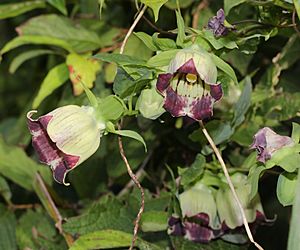Deodeok facts for kids
Quick facts for kids Deodeok |
|
|---|---|
 |
|
| Scientific classification | |
| Genus: |
Codonopsis
|
| Species: |
lanceolata
|
Codonopsis lanceolata, also known as deodeok or lance asiabell, is a beautiful flowering plant. It grows naturally in East Asia, including China, Japan, Korea, and the Russian Far East. This plant is a type of bonnet bellflower.
Contents
What is Deodeok?
Deodeok is a strong plant that grows like a vine. It can reach up to 1.5 meters (about 5 feet) tall. Its flowers look like bells and are purple inside. They usually bloom from August to September. After the flowers, the seeds are ready between September and October. Bees and wasps help pollinate these flowers.
Where and How Deodeok Grows
Deodeok likes to grow in damp places in forests. You can find it on low hills or mountains, usually between 200 and 1600 meters high. It grows best in soil that drains water well and has plenty of moisture. The plant prefers a neutral or slightly acidic soil. It can grow in full sun or partial shade.
Both the leaves and the roots of the deodeok plant can be eaten. You can eat them raw or cooked. People also use deodeok in traditional medicine for different health issues.
Sometimes, slugs and snails like to eat the young shoots of the plant.
Farmers and gardeners can grow deodeok from its seeds. The seeds are planted on the surface of special soil. You can also grow new plants by dividing the roots. However, you need to be very careful because the plant does not like its roots to be disturbed.
Deodeok is grown for sale in Hoengseong County, Gangwon Province, South Korea. It is an important crop for the local farmers there. Many people in South Korea also grow a small amount of deodeok in their own gardens.
How People Use Deodeok
Deodeok in Korean Food
The roots of deodeok (더덕) are a popular ingredient in Korean cuisine. People eat them fresh or cooked in many different ways.
One popular dish is deodeok-gui. This is grilled deodeok roots that have been marinated in a tasty sauce. It is often served as a main dish, especially for vegetarians.
Deodeok can also be pan-fried, like a pancake, which is called jeon. It can be pickled to make a type of kimchi. You might also find deodeok in new and creative dishes, like salads.
Deodeok as Medicine
Besides being a food, Codonopsis lanceolata is also used as a natural medicine.
Images for kids







